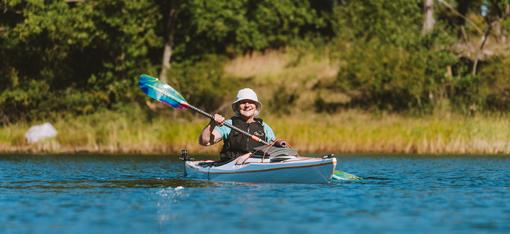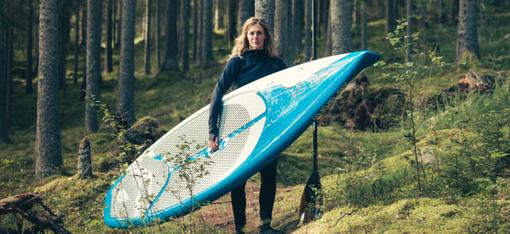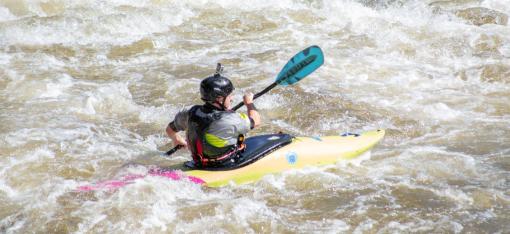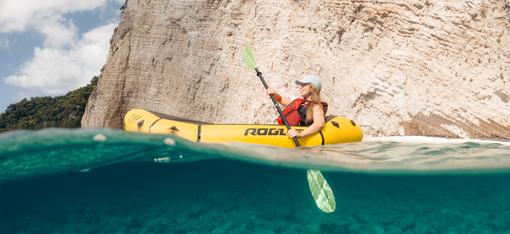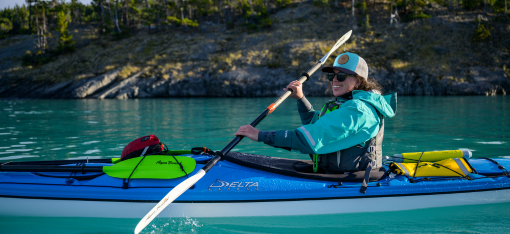Top 21 Questions People Ask About Sea Kayaking
13-minute read
Sea kayaking is a wonderful paddlesport that can take you to some amazing places in so many regions of the world. Here, we address some of the top questions people ask about sea kayaking.

Get Started and Sea Kayak Safety
1. What’s the difference between a sea kayak and a recreational kayak?
Sea kayaks are designed for big water (like the Great Lakes or the ocean) and multi-day trips with lots of watertight cargo space. Recreational kayaks are designed for short trips on sheltered water, like calm lakes and slow-moving rivers.
There are also kayaks in the “touring recreational” space. These perform better than budget rec kayaks, but aren’t as long as sea kayaks. They’re great for paddlers who prefer smaller water but want better speed and agility.
To learn more, read: Sea Kayak vs Rec Kayak: What’s the Difference?
2. Is sea kayaking safe for a beginner?
It can be! Big water has some pretty major characteristics you don’t have to think about in smaller environments, like large waves and tides on the ocean.
If you’re new to sea kayaking, we recommend going with a certified guide, preferably on a multi-day trip, as that’s the best way to learn. You’d be on the water for a few days in a row in varying conditions with an expert or two.
They’ll know the safest paddling spots for beginners, are familiar with the local tides and currents, and will bring you to beautiful places while teaching you all kinds of skills.
3. What essential safety gear do I need for sea kayaking?
A sea kayak (there are many high-quality brands to choose from), a reliable paddle and a comfortable paddling PFD that fits your body well. Those are the three most important gear items.
Then, it largely depends on where and when you’ll kayak. If you plan to take on big water that has the potential to throw up large waves, you’ll want a spray skirt, a bilge pump, a signaling device of some kind, and maybe a marine radio.
A towline, paddlefloat, First Aid kit and extra paddle are all good ideas, as well.
Finally, if you’ll paddle on cold water, you’ll need to invest in a wetsuit at a minimum, or a dry suit, preferably.

Serious sea kayakers who take on cold water routinely invest in a good dry suit (photo courtesy of Kate Wright)
To learn more, read: Kayak Touring: Getting the Right Gear
4. Do I need to know how to roll a kayak?
Let’s just say rolling your kayak is the easiest way to recover from a capsize. It isn’t absolutely necessary, though, as long as you don’t paddle alone on risky water.
If you plan to include sea kayaking as a big part of your life, we suggest you take a rolling class or two and then practice, practice, practice.
5. What’s the best way to get back into a kayak after capsizing in the open water?
The best way to re-enter a sea kayak after a capsize is with the help of another kayaker. Your buddy can come alongside your kayak, help turn it back over, then hold it steady for you as you climb back in.
You can practice this with friends on a calm, warm day!
6. How do I stay visible to other boats on the water?
That’s a great question. It’s really important that you’re visible to other boats, especially ones that are much bigger and faster than your kayak.
The best way is to think about high visibility when you make your purchases. Your kayak, your paddle blades, your PFD and what you wear on top can all contribute to being easily seen by other boaters.

High-visibility kayaks and gear make it easy for others in bigger, faster boats to see you
Another great idea is for you and your fellow kayakers to stick close together when there’s bigger boat traffic around you. It’s easier for someone in a big boat to see 4 kayaks together than to see one kayak over here and another over there.
When you’re out in your sea kayak, know where the bigger boats are and make it your responsibility to stay out of their way. You’re much more maneuverable than they are.
7. What should I wear for sea kayaking in different temperatures?
The rule is to “dress for immersion.” Dress as if you’ll be in the water, in case you end up in the water!
This is most important in cold water environments—and even more so if the air temperature is also cold. If you’ll be out in a remote area or for many hours, it’s also smart to bring along a dry bag with a change of clothes, a fire-starting kit and extra food.
A wetsuit will help keep your core body temperature a bit warmer to give you time to re-enter your boat or get to shore in case of a capsize. A drysuit doesn’t keep you warmer, per se, but keeps your inner clothes dry, so once you’re back in your boat, it's much easier to warm up again.
In hot, sunny weather, dress to keep the sun from burning you, including polarized sunglasses.
Choose and Use Sea Kayaking Gear
8. What is the best sea kayak for a beginner?
Tandem sea kayaks are long and wider, which makes them stable. If you and your spouse, friend or partner are interested in learning to sea kayak together, it can be a good option.
For a solo sea kayak, you may want to start with a shorter model that’s easier to handle for storage, transporting and paddling. Look for one that’s stable, and that you can adjust to your body size (foot pegs, knee braces, etc).
There are many fine kayak makers out there. We suggest you head to a nearby paddlesports shop and get some help from their knowledgeable staff.
9. Should I choose a sit-in or a sit-on-top kayak for the sea?
Most sea kayaks are sit-in, so you can use a spray skirt and have the airtight bulkheads that keep it afloat in case of a capsize.
That said, some sit-on-top models are long and stable, and designed for the rolling waves of the ocean. For example, there are ocean-going fishing kayaks available that are sit-ons.
What you don’t want to take is a recreational kayak of either type on the sea!
10. Do I need a rudder or a skeg on my sea kayak?
Most sea kayaks have a skeg or rudder that you can use when you choose to. They can help a lot in some situations—particularly when it’s windy. A skeg will help your kayak continue straight on instead of “weathercocking” into the wind.

(Photo courtesy of Aaron Wood and Paddle TV)
11. What’s the best way to transport my sea kayak on my car?
If you’re going to buy a sea kayak, the best way to transport it is to have a rack on your vehicle. One that’s designed for kayaks is optimal, but standard racks also work.
Cam straps make it easy and quick to tie it down, along with bow and stern lines to keep it extra steady while you drive.
To learn more, read: Tie Down Your Kayak to Your Vehicle Quickly and Easily
12. How do I properly hold and use a sea kayaking paddle?
Your paddle is the most important component of kayaking, because it’s your motor. It’s what’s contacting the water and propelling you where you want to go.
Position your hands at an equal distance from the center of the shaft (called the ferrule) with your elbows at about a 90º angle. Relax your grip and stay loose.
Use your whole torso with each stroke, not just your arms and shoulders. Not only is this more efficient, it’s less tiring.
Some paddles are designed for a more horizontal and relaxed stroke—called “low angle.” Others are designed for a more vertical and aggressive stroke—called “high angle.” The blades are shaped differently for each type, so when you shop for your paddle, think about which style you’ll do most often.

Low-angle paddles (on the left) have longer, narrower blades than high-angle paddles (photo courtesy of Andrew Strain)
To learn more, read: Basic Kayak Paddling Technique for Every Kayaker
13. How much gear can I fit in a sea kayak for a multi-day trip?
More than you think! The key is to pack your gear into smaller dry bags vs one or two larger packs like you would in a canoe. This is so you have a lot of flexibility for where you stuff them in the boat.
Sea kayaks have several watertight bulkheads that get narrower as they get closer to the bow and stern. Keep in mind, even though we say “watertight,” anything can get wet when you’re kayaking. That’s why we recommend putting everything in dry bags.
Paddling Skills and Navigation
14. How do I paddle effectively and efficiently for long distances?
There are a couple of big keys to this:
First, buy a “low-angle” kayak paddle, like we just discussed above. Low-angle paddles have a blade design that’s long and narrow, perfectly suited to long days on the water. They offer less resistance than the high-angle blades, so you’re strokes are more efficient.
The second key is to use your whole body when you paddle, not just your arms and shoulders. We mentioned this already, too. “Torso rotation” is key to the power behind your strokes and the ability to keep going for hours with less fatigue.
Your legs are even involved in sea kayaking, taking advantage of the foot pegs to lean into each stroke.
15. How do I navigate and read charts on the water?
Navigating and map reading are skills you can learn and practice. At first, we recommend sea kayaking with more experienced paddlers so you can get feedback on what you think the chart is telling you (things can look very different on the water than on the map!).
Keep a compass with you and know how to use it. This will help keep you oriented according to the map on overcast days or in complex situations, like in an archipelago of islands.
16. How do I deal with wind, waves, and currents?
The best way to learn to paddle your sea kayak in wind, waves, and currents is to have your paddle strokes down pat so they’re second nature. You want to be able to turn your kayak in any direction you choose on calm water before you’re ready to tackle more challenging conditions.
Thankfully, sea kayaks are made for these types of conditions. Gradually work your way up so you’re confident in your skills. We suggest you take some sea kayaking courses from a certified instructor so you can stay safe while learning.
Read more here: How to Best Handle Wind and Current When on the Water

17. What are tides and how do they affect my paddling?
Tides are the movement and depth of the water along the ocean coastlines and in tidal areas where rivers spill in. Some tides are gentle while others can be aggressive with strong currents.
You always want to research the tidal patterns of any area where you want to kayak. Check with the locals for their suggestions. If you’re new to ocean kayaking, go on a local tour first before you head out on your own.
18. How do I launch and land my kayak in a surf zone?
Look for a gradually sloping beach vs one that’s steeper. It’ll allow you to walk your kayak out into the water. If you need to, wait for a bigger set of waves to move through before you launch.
Once you’re ready, keep your kayak pointed directly into the oncoming waves and paddle hard through them. It’s a great idea to do this with a friend, someone to help you position your kayak and stabilize you.
Landing is similar—wait for a smaller set of waves to begin. Then let the waves roll your kayak along. Don’t let your kayak turn sideways, but keep the bow pointed toward shore. Once you’re on the beach, jump out right away and drag your boat further up the beach.
For more details, read: How to Launch Your Kayak in a Surf Zone

(Photo courtesy of Rob McNamee)
19. How far from shore can I safely paddle?
The answer to this depends on quite a few factors:
- How experienced and skilled are you?
- What safety gear do you have along?
- Do you have a proficient roll?
- If you capsized, would your life be in danger if you couldn’t re-enter your kayak or get to shore within a few minutes?
- Are there a lot of big, fast boats the further out you go?
- How big are the waves? How much wind is there?
- Are you alone or with other kayakers? How experienced are they?
See what we mean? The newer you are to kayaking, the closer to shore you want to be. The more risky the situation (i.e., cold water, big waves), the closer you want to stay to shore. Solo paddlers are safer closer to shore.
20. What is a "wet exit" and how do I practice it?
A “wet exit” is when you release your spray skirt and roll out of your kayak after a capsize. You’ll be underwater while you do it, so it’s important that you do learn it and practice it.
Key #1 is to be sure the grab handle of your spray skirt is easy to grab. Key #2 is to practice it on a warm, calm day in warm water until you’re comfortable with it. Then you won’t freak out if you should happen to need to wet exit in tougher conditions.
Along with practicing a wet exit, practice reentering your kayak with a fellow kayaker’s help.
21. How do I plan a sea kayaking trip, including route, gear, and safety considerations?
Preferably with someone who’s done it before!
A basic guideline if you’re on your own: Know your own skill level and don’t attempt a sea kayak trip above it. Take the information we’ve shared here, get experience sea kayaking, collect the needed gear, learn and practice safety and rescue skills, and ask questions of those who are more experienced.

Sea kayaks can handle quite a lot of gear in their bulkheads
If you’re new to sea kayaking, we suggest you sign up for a multi-day sea kayak trip near you or in a destination you want to know more about. You’ll get a lot of great information from the guide(s). The outfitter will provide much of the gear. Most guides love teaching trip participants as much as they want to know, so ask lots of questions.
What paddling questions can our friendly Customer Service team help you with? Contact us at 715-755-3405 or sales@aquabound.com, or choose our online chat option.
More for you...

